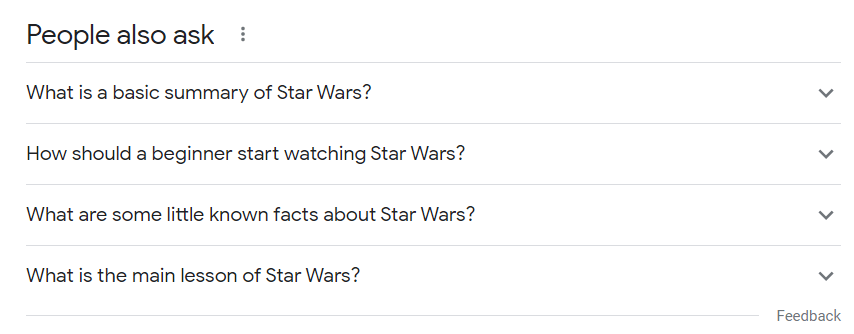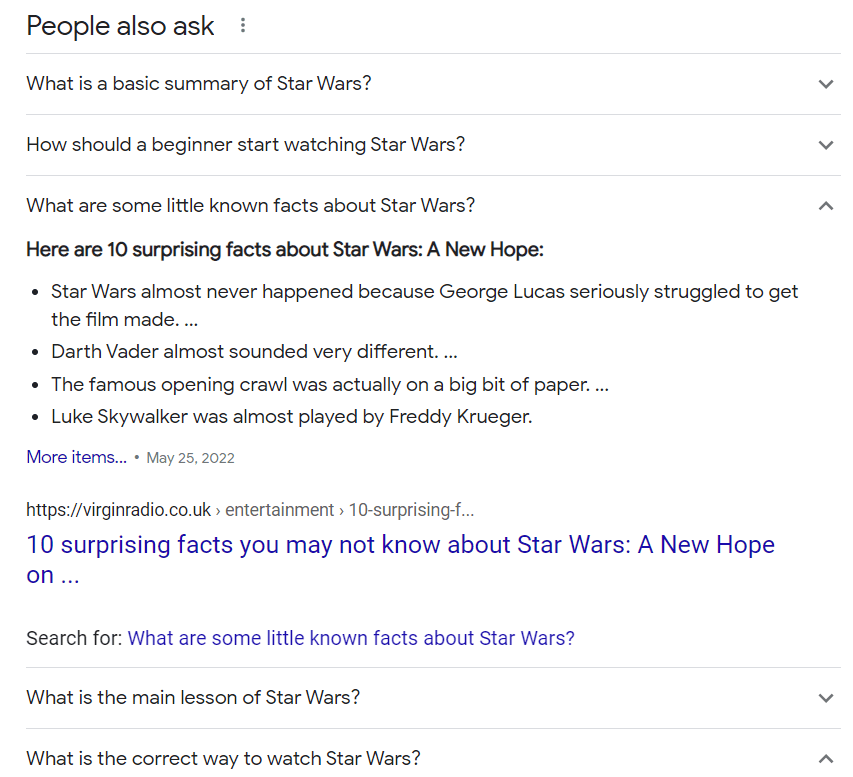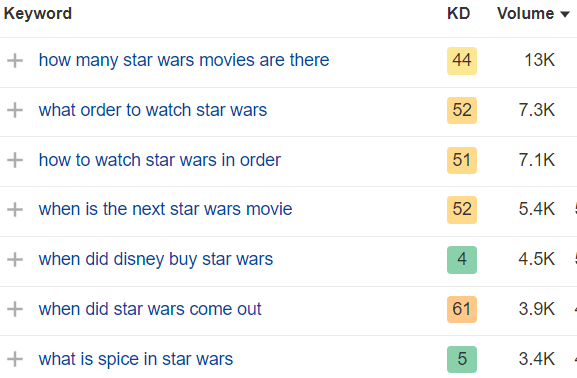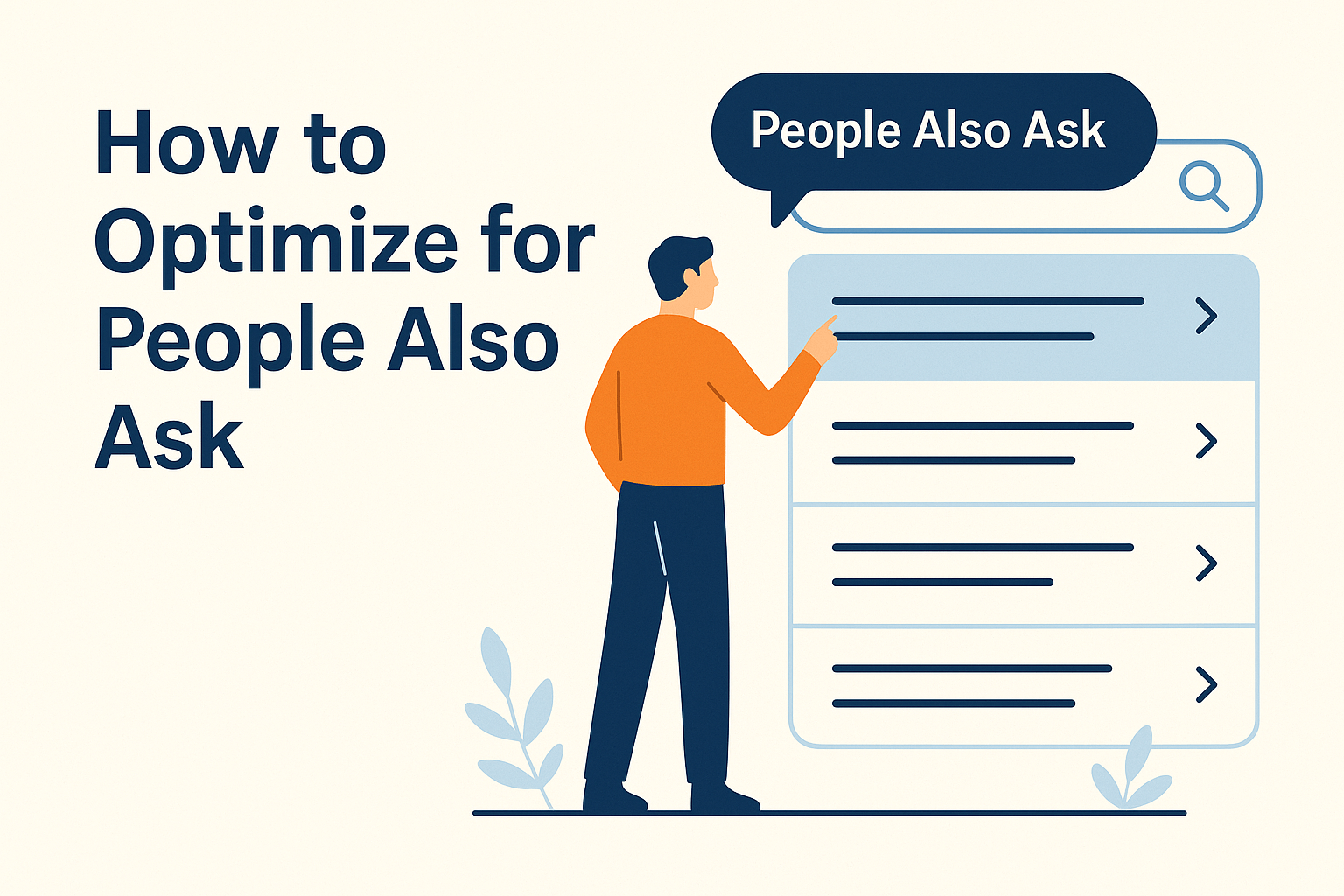Google’s People Also Ask (PAA) feature is a clever search tool that presents users with related questions and answers neatly arranged in expandable boxes. It is a valuable resource, allowing users to dive deeper into their queries and explore pertinent information. PAA provides websites with an extra platform to showcase their work, leading to improved visibility and engagement.
The PAA feature carries significant importance for searchers, as it assists them in finding relevant information swiftly related to what they originally searched for. Websites can use PAA to target popular topics and queries, thus boosting their chances of being featured in PAA results and driving more website traffic. RicketyRoo wants to share how we approach PAAs to help you leverage them in every piece of content.
What Are People Also Ask Boxes?

PAAs are interactive boxes in Google search results, displaying a list of related questions to the user’s initial query. When a user clicks on a question, the box expands to reveal a concise answer and a link to the website featured in the answer. These boxes provide users with different contexts related to their search query.
What’s the Purpose of PAAs?
PAAs enhance the search experience by offering users quick answers and related questions without the need to navigate away from the search results page. By presenting a series of associated questions, PAA encourages users to explore topics more thoroughly, uncovering valuable information they may not have discovered through a single search. This feature also helps users refine their search queries by revealing popular and trending questions related to the topic they may not have realized were connected.
How Do PAAs Work Their Magic?
Google’s algorithms select questions and answers to be featured in the PAA boxes based on several factors, including:
- Relevance of the content to the user’s query
- Authority of the source
- Quality of the provided answer
Google may also consider the user’s search history and preferences to display personalized PAA results. The PAA section can dynamically change as users interact with it, revealing new questions and answers based on the user’s selections. Location can also play a part in whether PAAs show. If localized results related to the original search query are relevant, they’ll show up as PAAs for you to continue down the rabbit hole from the original question asked in Google.
Dynamic Aspect of PAAs

One intriguing aspect of the PAA feature is its dynamic nature. As users click on questions within the PAA box, Google may generate additional related questions based on the user’s engagement. This dynamic behavior helps users uncover more relevant information and explore a topic in-depth. Essentially, you could go from one PAA to another for hours at a time.
Significance of PAA for Websites
PAAs offer a fantastic opportunity to gain additional visibility in search results. By optimizing content to answer popular questions and target relevant keywords, websites increase their chances of being featured in PAA results. This increased visibility drives more website traffic and establishes their content as a valuable resource for users.
Understanding the purpose, mechanics, and importance of Google’s People Also Ask feature can help searchers and websites make the most of this valuable search tool. By offering related questions and quick answers, PAA enhances the search experience and allows websites to showcase their work and expertise.
Benefits of People Also Ask for Searchers
People Also Ask provides numerous advantages to searchers, enhancing their overall search experience and helping them uncover valuable information. Here are some of the many ways PAAs help searchers find what they were looking for – and what they didn’t realize was connected:
- Adding context: PAAs offer users valuable context by presenting questions and answers related to their search query. This additional context can help users better understand complex topics and give them a broader perspective on their research subject.
- Simplifying information discovery: The PAA feature streamlines the discovery process by compiling multiple answers and related questions in one location. Instead of navigating through multiple websites or search results, users explore various questions and answers directly on the search results page.
- Encouraging deeper exploration: PAAs inspire users to dive deeper into their search topics by presenting related questions they might not have considered otherwise. This feature can lead users to discover new aspects of a subject, broadening their knowledge and understanding.
- Offering quick answers: The expandable nature of the PAA boxes allows users to access quick answers without leaving the search results page. This feature saves time and effort, enabling users to find relevant information more efficiently.
- Enhancing search personalization: Google’s algorithms can personalize PAA results based on a user’s search history, preferences, and behavior. This personalization ensures that the PAA questions and answers displayed are more likely relevant and helpful to individual users.
- Identifying popular questions: PAAs can help users identify popular and trending questions related to their search queries. By presenting commonly asked questions, users can gain insights into the topics others find important or exciting, enriching their research and understanding.
The People Also Ask feature is a powerful search tool that benefits users in various ways, from providing additional context to simplifying information discovery and encouraging a deeper exploration of topics. By understanding these benefits, searchers can make the most of the PAA feature and enhance their search experience. At the same time, websites can better tailor their content to meet the needs and interests of their target audience.
How to Identify PAA Opportunities
 Embarking on the search for PAA opportunities requires a blend of strategy and creativity. Here’s RicketyRoo’s quick guide to help you identify chances to land in Google’s People Also Ask boxes:
Embarking on the search for PAA opportunities requires a blend of strategy and creativity. Here’s RicketyRoo’s quick guide to help you identify chances to land in Google’s People Also Ask boxes:
- Conduct Keyword Research: Invest time in local keyword research or more generic research to discover the most relevant terms and phrases in your niche. These keywords will inform your content creation and help you pinpoint PAA questions that pertain to your expertise.
- Collect Audience Feedback: Ask your audience for their questions and concerns through surveys, polls, and social media interactions. Use this feedback to identify potential PAA opportunities that resonate with your target audience.
- Observe PAA Boxes: Explore Google’s search results and pay attention to the available PAA boxes. Analyze the questions and answers within these boxes to gather insights and ideas for your content.
- Analyze Competitors: Examine your competitors’ content to identify the PAA questions they’ve captured. Learn from their successes and strategize ways to find unique PAA opportunities they may have overlooked.
- Explore Q&A Platforms: Visit Q&A forums and social media discussions, such as Quora, Reddit, and industry-specific forums, to uncover trends and patterns in questions and queries that signal potential PAA opportunities.
- Monitor Trends: Use trend analysis tools to stay ahead of emerging topics and themes in your niche that could lead to new PAA opportunities.
- Use Tools: AlsoAsked, Semrush, Ahrefs, and QuestionDB, offer ways to discover PAAs for big picture keywords. These tools can save you time during the research process. There are a lot of tools out there to both find and even scrape PAAs – find the ones that work best for you.
- Leverage Search Itself: Take advantage of search tools, like Google’s Related Searches, to find related topics and questions that reveal new PAA opportunities for your content. FAQ rich results are another search feature to pay attention to for PAA discovery.
By following these tips, you’ll be well-prepared to uncover PAA opportunities and leverage them to increase your visibility, engagement, and website traffic.
Writing Content That Addresses PAA Queries
Creating content that effectively addresses People Also Ask queries significantly boosts your online visibility and drives more traffic to your website. To achieve this, it’s essential to follow a series of proven strategies that help you develop relevant, authoritative, and user-friendly content.
Let’s dive into the critical approaches to writing content that RicketyRoo uses to address PAA queries.
Ensure Relevance
Crafting relevant content is crucial for addressing PAA queries. Here’s how to ensure relevance:
- Conduct comprehensive keyword research to identify the terms and phrases users search for about your topic.
- Align your content with search intent by understanding and addressing your target audience’s needs or problems.
- Regularly update your content to maintain its accuracy and relevance in the ever-changing digital landscape.
Establish Authority and Trustworthiness
To be featured in PAA results, your content must be authoritative and trustworthy. Showcase your expertise and experience by providing in-depth, well-researched content, and include author bios highlighting your credentials. Use credible sources to support your claims and provide clear author information to establish transparency. Build your online reputation through social media, guest blogging, and other platforms to increase your credibility in your niche.
Implement Structured Data
Structured data helps search engines understand and index your content more effectively, increasing the likelihood of being featured in PAA results. Use schema.org markup to provide additional information about your content, and choose appropriate schema types to describe your content accurately. Validate your structured data using tools like Google’s Structured Data Testing Tool to ensure proper implementation.
Optimize User Experience and Engagement
A positive user experience is vital for retaining visitors and increasing the chances of your content being featured in PAA results. Optimize your website for mobile devices, improve site load times to minimize bounce rates, and use straightforward navigation and descriptive headings to facilitate content consumption. Incorporate visuals like images and videos to enhance user engagement and analyze engagement metrics to identify areas for improvement.
Answer Questions Clearly and Concisely
To effectively address PAA queries, structure your content logically with headings and subheadings that guide readers through the information. Use the inverted pyramid style, placing the most important information at the beginning and less crucial details later. Incorporate FAQ sections in your content to address common queries directly and concisely. At the local level, leveraging FAQs is an easy way to address common customer questions before they ask you.
Keyword Optimization
Strategically use keywords and related phrases throughout your content to increase its relevance for specific queries. Don’t stuff keywords into your writing if it doesn’t make sense. Include long-tail keywords and variations to capture a wider audience and address more specific search queries. Monitor keyword trends and search volumes to stay up-to-date and adjust your content strategy accordingly.
Earn High-Quality Backlinks
High-quality backlinks signal to search engines that your content is valuable and authoritative, increasing the likelihood of being featured in PAA results. Create link-worthy content that attracts natural backlinks, contribute guest posts and articles to relevant websites, and monitor your backlink profile to maintain a healthy link profile. If you’re focused on local content, consider local link building to maintain relevance in the geographic area you’re targeting.
By following these strategies, you can create content that effectively answers PAA queries, increasing your chances of being featured in PAA results and driving more traffic to your website. Remember to monitor your content’s performance and adapt your approach to stay ahead in SEO and content marketing.
Optimize Your Content for PAAs and Reap the Benefits
Google’s People Also Ask feature presents a valuable opportunity for websites to boost their visibility and drive more traffic. By understanding PAAs and their benefits to users, you can optimize your content to target relevant questions and queries, making it more likely to be featured in PAA results.
Implementing the strategies outlined in this guide, such as ensuring relevance, establishing authority, and optimizing user experience, will increase your chances of success in the competitive online landscape.
As you put RicketyRoo’s process into practice, we encourage you to share your experiences and successes with PAA optimization. By learning from one another, we can all improve our content and benefit from the advantages of mastering Google’s People Also Ask feature.
Want content that makes a statement?
Schedule a discovery call with RicketyRoo
and discover a new chapter in your content marketing.



